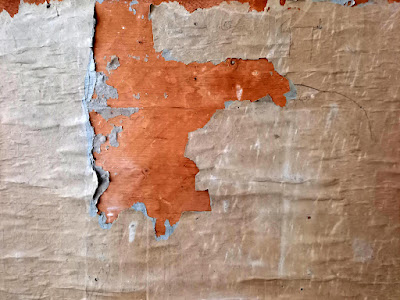A week ago I trekked (via car) to Thurles in Tipperary to The Source Arts Centre in order to see Eamon Colman's exhibition of recent work, Into the Mountain. The Source is nicely situated in the middle of town next to the river. I don't know how all those clouds made it into the picture, I thought it was a sunny autumn day...
Musings about art, writing, music, travel and food (life, the universe & everything...) by Lorraine Whelan
Wednesday, 29 September 2021
Eamon Colman "Into the Mountain"
Wednesday, 22 September 2021
Rathfarnham Castle - wall textures
A few weeks ago I was at Rathfarnham Castle to see the current exhibitions, which I blogged about here and here, but I also wanted to have some photos taken of the various wall textures. From previous blogs, about Rathfarnham Castle and other old and/or ancient sites, you will already know how these things fascinate me! As I am getting a small brochure made for my own exhibition, Memory Is My Homeland, in Rathfarnham Castle next spring, I decided I wanted some of the building's texture to feature in the background of the brochure, images of my artwork and information in the foreground. The first floor of Rathfarnham Castle, where the exhibition will be, features amazing walls especially in The Dining Room, where most of these pictures were taken.
Wednesday, 15 September 2021
Kingston Road: Waiting - painting finished!
I thought that the large Knockeen was going to be the last painting in this series, but then I had some ideas to do a few more, so got to work. The first of the new paintings was also going to be the largest, but considerably smaller than Knockeen and Kingswood. I decided I wanted the works to be stretched and in doing so discovered that pressed cloth is a lot more difficult to stretch than canvas! However, I do like the unpredictability of painting on this material and think it is appropriate to the concept of memory as being sometimes blurry and unreliable, so I carried on.
I started painting, as usual, by working out the composition in yellow. I fully expect some of the yellow lines to show through in the final work and like the idea of revealing the process as I go along.
For all previous works from the Memory Is My Homeland series, please do a simple search within this blog (I have made many posts of the works in progress and completed). Also, the origins of this project may be found under the label The Home Project, as I called it when I hadn't yet decided on a name for the work.
Wednesday, 8 September 2021
Pathos - exhibition at Rathfarnham Castle
I was initially planning to write something about the Pathos exhibition last week to follow up on my post about the Diana Copperwhite exhibition that was showing at Rathfarnham Castle at the same time. However, I got sidetracked by the Pluid: National Comfort Blanket exhibition at Farmleigh House, which I thought deserved more urgent attention. Anyway, I blogged about Diana Copperwhite's exhibition here, so now I will continue where I left off.
This is an overview of the Pathos group exhibition in the "Pistol Room", which is just off the larger rooms on the first floor where Copperwhite's work is displayed. I am not sure of the point of the show's title because, other than one particular piece of an empty room, I did not think the work largely connected me to feelings of pity or sadness.
Wednesday, 1 September 2021
Pluid - The National Comfort Blanket
This week I had intended to write about the other exhibition, Pathos, at Rathfarnham Castle, but after seeing the Pluid exhibition on Sunday, I decided it was a priority because it is a fundraiser in which all of the works may be viewed here and many are available for auction in aid of Pieta House, a charity with a mandate for suicide prevention. I blogged about the Pluid Project back in April of this year when I decided to get involved; you can see that post here. While the initial intention of the project was to create a National Comfort Blanket where the individual contributions would be sown together into one giant work, it soon became apparent to the organisers, Claire Halpin and Madeleine Hellier, that both the variety of media and the number of artworks involved would make this an impossible task. Instead, the numbered works were laid out on a long platform and visitors to the exhibition could make their way around the table to view the squares.







































